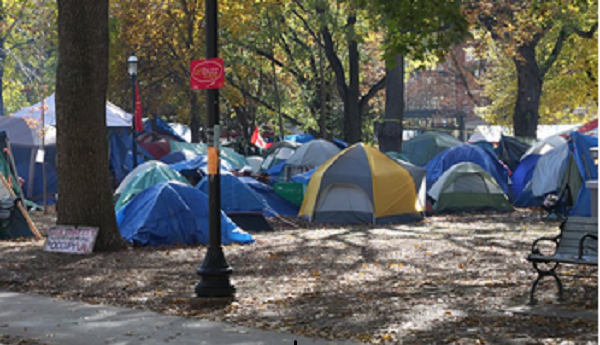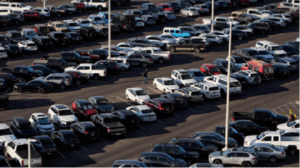Toronto’s tent encampments expanding into areas they’ve never been found with up to a 20% increase
You never used to find tents in Scarborough’s Collingwood Park.
The tiny oasis of greenspace tucked near Sheppard Avenue East and Kennedy Road is usually home to little more than grassy expanses, winding paths, a narrow creek and play equipment. But this spring, as outdoor homelessness has continued to surge across Toronto, 11 campsites were set up throughout the park.
Last spring, there was only one; in the three springs before, none at all.
The rise in tents along the banks of West Highland Creek is part of a more than 20 per cent increase in encampments across Toronto year-over-year, with many tucked into ravines and more isolated corners of the map. A whopping 248 tents and other makeshift structures were counted across 81 locations as of March 15, city data shows, up from 202 camps in 72 locations on the same day in 2024.
Another 35 people were counted by the city’s transportation department, some in tents and others sleeping rough under bridges and overpasses without shelter. Others may have eluded the official count, shielded from view in less traversed areas.
And despite a new city strategy and tens of millions in extra federal funding to tackle the growing problem, Greg Cook, a veteran outreach worker with Sanctuary Toronto, expects those numbers to keep rising as the weather gets warmer.
The shelter system is constricting, Cook said, with warming centres and other winter expansion beds closing down. Already, in February, an average of 101 people per day were turned away from shelter for lack of available beds.
“There’s nowhere for people to go,” Cook said.
A Star database, compiled over the last five years based on point-in-time counts from city hall on the same spring date, shows a shift in outdoor homelessness since the pandemic. During COVID-19, large, tightly clustered encampments sprung up in central areas such as Lamport Stadium Park and Trinity Bellwoods Park. Since then, visible homelessness has spread far from the core, to the Toronto Islands and the city’s deepest east, west and north corners.
There are still numerous large encampments closer to the city centre, the data shows. Dufferin Grove Park has the largest camp on record this spring, with 24 known tents or other structures as of March 15. That camp grew throughout last summer from zero camps one year ago. Riverdale Park East was home another large concentration, with 17 camps, and another 16 were counted at Alexandra Park.
Meanwhile, in further reaches of the city, tents and structures were observed in places they haven’t been seen in previous springs’ counts — from Derrydowns Park along the Black Creek ravine to West Hill’s Galloway Park.
This year’s data continues a trend seen in recent years, where camps have been counted in more isolated and foliage-concealed locations — for example, along the route of the Humber River. Twelve campsites were also recorded within the Rosedale ravine lands, the highest number counted there on March 15 since 2021.
As for Collingwood Park, Cook suspects the sharp growth is likely tied to the gradual closure of the nearby Delta hotel shelter, one of many temporary shelters set up during the pandemic. In December, the Star spoke with one man staying in a makeshift camp along the creekside through the biting winter cold, who said he lived at the Delta shelter for more than a year, but was offered only one alternative as his floor was emptied out — a space in a downtown dormitory shelter he saw as worse than surviving on the streets.
This data is only a snapshot of a fast-changing landscape, as people surviving on the city’s streets and parkland can move on a day-to-day basis, or face forced ejections. While the data shows nine tents in Trinity Square behind the Eaton Centre as of March 15, city hall cracked down on camps in that public square last week, telling remaining occupants they could no longer stay.
City spokesperson Elise von Scheel said efforts had been underway to move people voluntarily for some time, but confirmed anyone still encamped in the square last Thursday was given two options — to accept the shelter on offer, or to leave. Of the 11 people city staff counted as camping in Trinity Square last week, von Scheel says six moved into shelter, while five simply packed up and left.
Von Scheel described the city’s approach to Trinity Square as similar to how it has recently handled other prioritized encampments such as Allan Gardens, downtown Clarence Square and the waterfront’s Little Norway Park. Those are among locations where city hall has deployed a new strategy, approved mid-last year, which concentrates housing offers and other services in specific locations.
The strategy is multi-pronged, using security to prevent new tents from being struck while rolling out resources from tax clinics to housing offers for existing occupants. While it still allows for clearings, housing was meant to be the priority.
The city’s approach recently received a boost from the federal government, who agreed to provide $25.8 million for efforts that include hiring 20 more outreach workers for the city’s Streets to Homes team and partnering with health-care and addictions service providers.
Still, city officials have acknowledged the scale of Toronto’s homelessness crisis means having to prioritize the resources available.
One that resource outreach and housing workers have leaned on heavily in recent years to help people get off the streets and out of shelters is a portable federal-provincial rent subsidy program, which helps make up the difference between private market rents and what low-income Torontonians can afford. Applications are currently closed, with city hall saying it’s working out the details of contributing more municipal funding and securing roughly 880 more subsidies “while waiting for the next (funding) allocation from the Province.”
With Trinity Square now empty of tents — the sole remaining sign of the city’s housing affordability crisis is a longtime memorial to those who’ve died while homeless — von Scheel says the city has three other priority encampments in its focus. Those are Dufferin Grove, Alexandra Park and St. James Park, she said.
Cook, who at the time of the new strategy’s introduction called it ”slightly better than the status quo,” believes focusing attention on larger, more visible camps is one factor driving people to more remote locations further outside the core.
“If you have more people outside, and they continue the clearing of more prominent locations, people are going to go to less prominent locations to reduce the likelihood that they’ll get cleared,” he said.
Lately, he’s also noticed more people setting up makeshift structures — made of tarps and other items people could find for free or buy for cheaper than a tent. There were fewer aid groups handing out tents on an emergency basis these days, Cook said, compared to during the pandemic. All around the city, he feels like the supports meant for those living on the margins — from food banks to other survival resources — are being spread increasingly thin.
The warm weather won’t help, he said. He expects to see numbers rise, noting last year’s continual escalation in encampments throughout the year.
Data provided to the Star shows an increase from around 200 known tents last spring to more than 500 by November. Torontonians will see more camps like Dufferin Grove, Cook predicted, as well as tents set up in more hidden areas.
“That’s what we’re seeing,” he said.
This article was first reported by The Star













